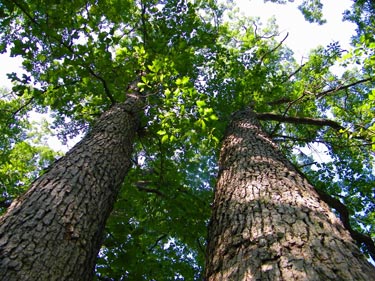In a study published in 2011, researchers found that more than half of the tree species in eastern U.S. forests are not adapting to climate change as quickly or consistently as predicted. Only about 21 percent of the species studied appeared to be shifting northward. With warmer temperature zones shifting northward, scientist expected to see the tree populations follow, but the study revealed that this is not the case with a majority of tree species.
The concept of climate-driven migration states that as temperature increases mature trees will die out, while young seedlings spread to northern areas with higher altitudes to take root in newly favorable climates. The researchers found little evidence to support the idea of climate-driven migration for many North American tree species. But there is one species defying the crowd. Recent research shows that the mighty oak is advancing northward by genetically transforming to adapt to climate change.
Jeanne Romero-Severson, associate professor of biological sciences at the University of Notre Dame, and her colleagues are tracking the live oaks of eastern North American to see how the trees adapt to climate change. Oak trees are originally from Southeast Asia, but can now be found all over the world. However, it is in North America that the highest diversity of oak species are located. Researchers have long thought that this diversity was attributed to the oaks ability to adapt to climate challenges. Romero-Severson’s studies focus on the migration of live oak into northern Canada, the diversity of oaks in North America and their ability to genetically transform to adapt to varying temperatures.
As reported by Phys.org, the researchers are hypothesizing that “trees in contact with a relative who could just manage to survive the cold were able to ‘capture’ from these relatives a few genes favorable for survival in colder climates, without retaining extensive genetic changes that would alter morphology.” The goal is to understand the role that climate change plays in the hybridization of the oaks and the general evolution of forest diversity. The study includes four research teams, each studying different aspects of how the oaks engaged in interspecies hybridization, while still maintaining species distinction. The unique thing observed in oaks is that the trees moving north acquire genes to survive in the different temperatures, while also maintaining all the genes that keep their species identity. Many species, animals and trees alike, have gone through similar adaptions, but lose the identity of the parent genes.
The mystery is how and why this tree species is able adapt so well and evolve which Romero-Severson and her team are just beginning to find out. Figuring this out will be completing a small piece of a much bigger puzzle: “We feel that we have to define the problem so carefully that what we learn from these live oaks will help us understand how evolution works and how natural adaptation arises,” says Romero-Severson. It will be interesting to see what the study reveals about how oak trees are adapting to climate change. It may even bring new insight into how other species, of all kinds, will adapt to climate change in the future.

